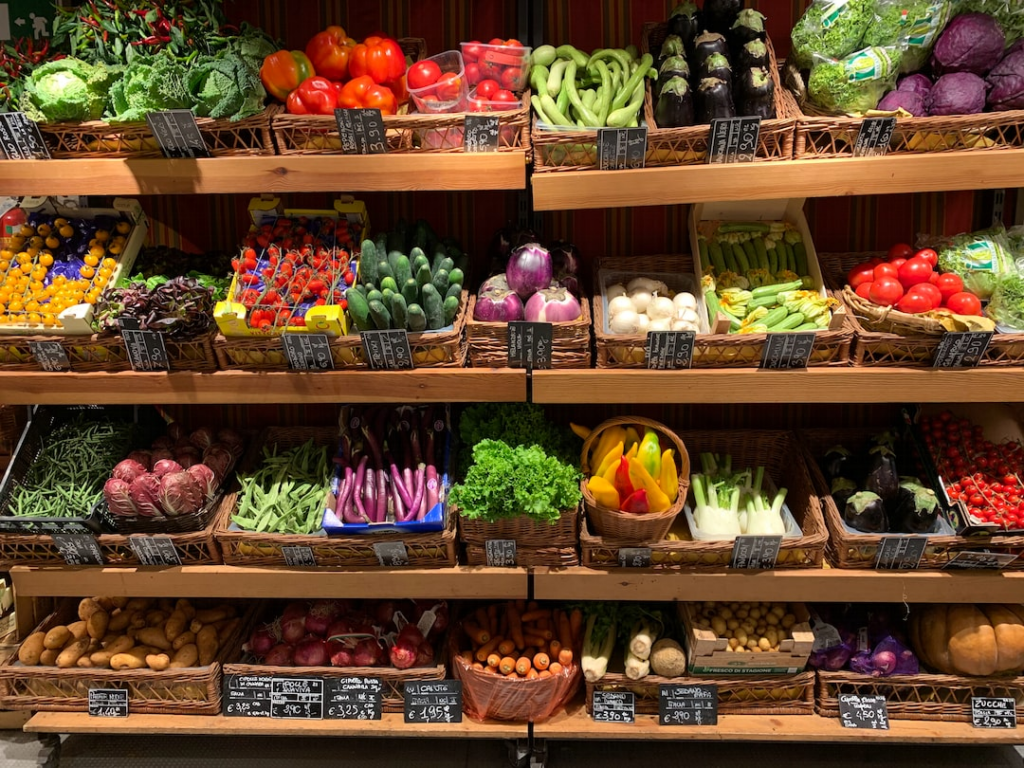Grocery shopping with the whole family can be a daunting task, but it doesn’t have to be! With a little planning and some clever strategies, you can turn this everyday chore into a fun and engaging experience for everyone.
In this article, we will explore 15 fun and easy tips for family-friendly grocery shopping. From involving your kids in meal planning to turning the shopping trip into a scavenger hunt, these tips will not only make grocery shopping more enjoyable but also help teach your children valuable life skills.
So, grab your shopping list and get ready to embark on a memorable and productive grocery shopping adventure with your family.

Set a Grocery Shopping Routine
When it comes to grocery shopping, having a routine can make the process more efficient and organized. By establishing a simple routine, you can save both time and money.
How? Well, it’s all about knowing exactly what you need and where to find it in the store. But it’s not just about that.
Involving your children in meal planning can be a valuable part of your routine. By sitting down together and discussing the meals you want to have for the week, you not only teach your kids about healthy eating, but you also give them a sense of belonging and responsibility within the family.
Another crucial aspect of your routine should be creating a shopping schedule. By designating specific days for grocery shopping, you can ensure that you always have fresh ingredients on hand and avoid those last-minute trips to the store.
Consistency is key in maintaining your routine, as it helps you stay organized and reduces stress.
Plan Meals and Create a Shopping List Together
As a family, we make it a regular part of our grocery shopping routine to plan meals and create a shopping list together.
Meal planning is crucial because it ensures that we’ve nutritious and delicious meals throughout the week. This not only saves us time and money, but it also promotes healthier eating habits.
When we involve our kids in this process, they feel a sense of ownership and excitement about what we’ll be eating. We gather as a family and brainstorm ideas for healthy meals, taking into account everyone’s preferences and dietary needs.
This not only strengthens our bond but also educates our kids about nutrition and the importance of balanced meals.
Turn Grocery Shopping Into a Game
During our family grocery shopping trips, I like to turn the experience into a game. It not only makes the task more enjoyable, but it also helps to involve my children and make them feel like an important part of the process.
There are many fun grocery shopping games for kids that can turn a mundane chore into an exciting adventure. One way I involve my children is by turning grocery shopping into a learning experience. We play a game where they have to find specific items on the list and learn about their nutritional value or where they come from.
Another creative idea is to give them a small budget and let them choose a snack or treat of their choice.
Let Kids Choose Healthy Snacks
When it comes to letting kids choose healthy snacks, I believe in involving them in the decision-making process. By offering a variety of nutritious options, I give them the opportunity to make their own choices while also learning about the importance of nutrition.
I make sure to include healthy alternatives such as fresh fruits, vegetables, whole grain crackers, and yogurt. To make it even more enjoyable, I sometimes turn snack selection into a fun game. I set up a taste-testing station where kids can try different snacks and rate them.
This not only encourages their active participation but also helps them develop their taste preferences and learn about nutrition. By involving kids in snack selection and making it a fun activity, we create a sense of belonging and empower them to make healthier choices.
Teach Children About Different Fruits and Vegetables
I enjoy teaching my children about different fruits and vegetables. It’s not only educational but also a fun way to spend quality time together as a family.
To introduce them to new and exciting fruits, we’ve had ‘fun fruit’ sessions where we explore exotic options like dragon fruit, star fruit, and kiwano. We learn about their unique flavors and origins, making it a fascinating experience.
Another activity we love is creating veggie art. I teach my children how to use various vegetables to make beautiful and creative artwork. This not only nurtures their creativity but also helps them develop a fondness for vegetables.
We also have taste-testing sessions where we try different fruits and vegetables. It’s a fantastic way to expand their palate and discover new favorites.
In addition, we delve into the world of gardening by growing different types of fruits and vegetables in our backyard. It’s an exciting adventure that teaches them about the growth process and the importance of fresh produce.
Lastly, we visit our local farmer’s market to explore the different options available. This allows us to support local farmers and understand the benefits of buying fresh and seasonal fruits and vegetables.
Teaching children about fruits and vegetables is a valuable experience that provides them with knowledge, creativity, and a healthy appreciation for nutritious food.
Make a Scavenger Hunt for Items on the Shopping List
Making grocery shopping more engaging can be as simple as creating a scavenger hunt for the items on your shopping list. It’s a fun and interactive way to involve the whole family and transform a mundane task into an exciting adventure at the grocery store.
The objective is to find all the items on the list quickly, turning it into a shopping list race. To make your grocery store exploration even more enjoyable, here are some scavenger hunt ideas:
- Team up or compete individually.
- Look for apples, bread, milk, cereal, carrots, yogurt, juice, chicken, bananas, pasta, lettuce, eggs, tomatoes, potatoes, and cheese.
Involve Kids in Comparing Prices and Finding the Best Deals
To involve kids in comparing prices and finding the best deals, start by teaching them to look for the lowest prices on their favorite grocery items. You can make this a fun activity by playing price comparison games. Give each child a small shopping list and challenge them to find the best prices for each item. This not only teaches them about budgeting but also helps them develop essential math skills.
You can also share bargain-hunting tips with them, like checking for coupons or shopping during sales. Encourage them to find the best discounts and compare prices between different brands.
Create a Shopping Budget and Stick to It
Creating a shopping budget is a crucial step in family-friendly grocery shopping. It allows you to keep track of your expenses and ensure that you’re spending within your means. By establishing a realistic budget, you can make informed choices and prioritize your purchases.
Here are some practical tips to help you stick to your budget:
- First and foremost, take advantage of sales and coupons. Look for discounts and coupons to maximize your savings.
- Planning your meals in advance and preparing them can also be a game-changer. By doing so, you can create a shopping list and avoid buying unnecessary items.
- Additionally, buying in bulk can save you money in the long run and reduce the number of shopping trips.
Remember, it’s important to stay focused on buying the essentials and resist the urge to make impulse purchases. By following these tips, you can create a budget that suits your family’s needs and make the most out of your grocery shopping experience.
Use Technology to Make Shopping More Interactive
Using technology to make shopping more interactive can greatly enhance the experience for families. By utilizing interactive apps that offer recipes and meal-planning suggestions, families can actively participate in the shopping process.
Virtual reality shopping takes it a step further, allowing families to explore the grocery store right from their own homes, making it a fun and immersive activity.
Smart shopping carts equipped with digital grocery lists help families stay organized and ensure that no items are forgotten.
Augmented reality labels provide additional information about products, empowering families to make informed choices.
Give Kids Their Own Shopping Basket or Cart
I enjoy giving my kids their own shopping basket or cart when we go grocery shopping. It not only gives them a sense of independence but also helps them develop decision-making skills and promotes responsibility. Here’s why I think this is a great shopping experience for children:
- Grocery shopping independence: Allowing kids to have their own basket or cart gives them a sense of ownership and empowerment during the shopping trip.
- Fostering decision-making: Kids can make their own choices and decisions about what items they want to put in their basket or cart, which helps them develop decision-making skills.
- Promoting responsibility: Giving kids their own shopping basket or cart teaches them to take responsibility for their choices and actions while shopping.
- Engaging shopping experience: Having their own basket or cart makes grocery shopping a fun and interactive experience for children.
- Developing budgeting skills: Kids can learn about budgeting by understanding the limitations of their own basket or cart and making choices accordingly.
Try Out New and Exciting Recipes Together
Exploring new and exciting recipes together is a wonderful way for families to bond and expand their culinary horizons. When we cook together, it creates a sense of togetherness and belonging. Trying out new recipes allows us to go on culinary adventures and discover different cuisines, adding excitement and variety to our family meals.
Let me share some family meal ideas that we can try:
- Tacos (Mexican cuisine)
- Stir-fry (Asian cuisine)
- Pasta (Italian cuisine)
- Curry (Indian cuisine)
- BBQ (American cuisine)
Let Kids Help With Bagging Groceries
To involve my children in the grocery shopping experience, I let them help with bagging the groceries. This not only keeps them engaged but also teaches them valuable skills. Here are some benefits of involving kids in bagging groceries:
- Discussing bagging techniques: I explain the importance of packing items properly to prevent damage or spills. This helps my children understand the significance of being careful and organized.
- Teaching responsibility: By assigning them the task of bagging, I instill a sense of responsibility in my children to take care of their own belongings. They learn that their actions have consequences and that they play a role in ensuring the safety of the groceries.
- Promoting teamwork: Bagging groceries together encourages my children to work as a team, helping each other and cooperating. They learn the value of collaboration and how working together can make tasks easier and more efficient.
- Fostering independence: Allowing my kids to bag groceries gives them a sense of independence and boosts their confidence in handling tasks. They feel a sense of accomplishment and become more self-reliant.
- Building life skills: Bagging groceries provides an opportunity for my children to learn practical skills that they can use in their everyday lives. From organizing items to handling fragile products, these skills are transferable and will benefit them in various situations.
Involving kids in bagging groceries is a fun and educational way to make them feel included in the family shopping experience while teaching them important life lessons. It also strengthens our bond as we work together towards a common goal.
Make Grocery Shopping a Learning Opportunity
During grocery shopping, I transformed it into a valuable learning experience for my family. As we stroll through the aisles, we take the opportunity to explore various food groups and discover new ingredients. I actively encourage my children to read food labels and emphasize the significance of being aware of what we put into our bodies. Together, we engage in discussions about the nutritional value of the foods we select and how they contribute to our overall well-being.
Incorporating meal planning into our shopping routine is an essential aspect of our journey. We’ve had conversations about the importance of planning balanced meals and making healthier choices. By involving my family in the process, we not only cultivate healthy eating habits but also foster a sense of togetherness as we make informed decisions about the food we bring home.
As we explore the grocery store, we encounter specific examples of nutritious products that align with our goals. For instance, we might come across fresh fruits and vegetables that are rich in vitamins and minerals.
We may discover whole grains and lean proteins that provide essential nutrients. By incorporating these recommendations into our shopping cart, we ensure that our meals are both delicious and nourishing.
Encourage Kids to Make Healthy Choices
As we continue our journey through the grocery store, I actively encourage my kids to make healthy choices for themselves and our family. Teaching them about healthy eating habits is important to me, so I try to make it a fun and engaging experience.
Here are some ways I help my children make nutritious choices while enjoying grocery shopping:
- Exploring new fruits and vegetables: We make it a game to try something new each week. This introduces variety and teaches them about different nutrients.
- Involving them in meal planning: I ask my kids to suggest fun food choices for our meals. This gives them a sense of ownership and helps them understand the importance of balanced nutrition.
- Reading food labels together: I explain the significance of reading labels and help them understand what to look for, such as added sugars or unhealthy fats.
- Discussing the benefits of healthy eating: I talk to my children about how nutritious foods fuel our bodies and help us grow strong and healthy.
- Rewarding healthy choices: I praise and reward my kids when they make healthy choices. This reinforces positive habits and encourages them to continue making nutritious decisions.
Celebrate a Successful Shopping Trip With a Special Treat
After successfully encouraging my kids to make healthy choices during our grocery shopping trip, it’s time to celebrate with a special treat. Celebrating together as a family is a great way to reinforce positive behavior and create lasting memories.
Implementing a reward system can be an effective way to motivate children to make healthy choices. By offering healthy rewards, such as a post-shopping treat, you can teach your kids that making good choices can be fun and enjoyable. This not only strengthens their understanding of nutrition but also promotes family bonding.
To make it even more exciting, you can create a simple reward chart and let your kids track their progress. For example, they can earn points for eating fruits, drinking water, and choosing whole grains. Once they accumulate enough points, they can enjoy rewards like a movie night, an ice cream outing, or a park visit.
Conclusion
Grocery shopping with the family can be a fun and educational experience. By involving the kids in the process and turning it into a game, you can make it enjoyable for everyone.
Letting the little ones choose their own healthy snacks and teaching them about different fruits and vegetables sparks their curiosity and helps them develop healthy habits.
Grab your shopping cart and embark on this exciting journey of family-friendly grocery shopping.











